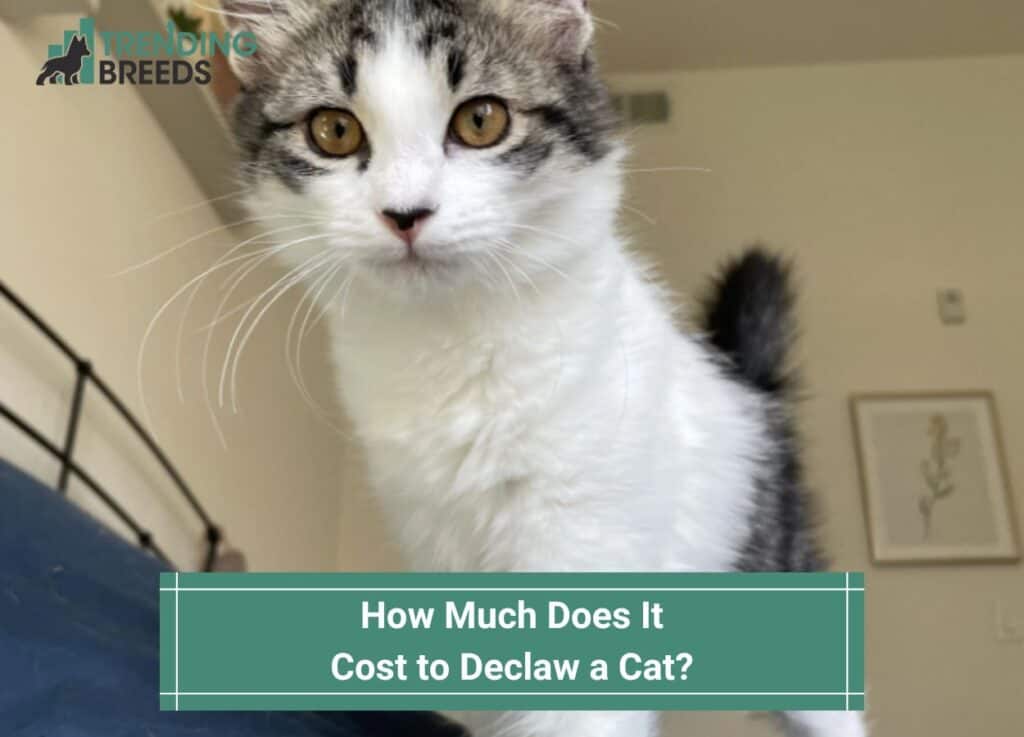
Declawing is a controversial procedure in the world of pet care. What is the cost of declawing a cat?
Animal care professionals and veterinarians worldwide strictly advise against getting cats declawed. Cats need claws for everything, including climbing, scratching, and bathroom use.
On average, declawing a cat can cost you about $200 to $800. But it can cost a cat quality of life and cause lifelong pain and problems that affect how they do everyday things.
Of course, it can increase with other factors, such as if your cat needs extra care based on age and weight or if any complications arise during or after the procedure. Cats who have been declawed are more likely to develop behavioral problems, bathroom problems, paw pain, back pain, infections, tissue necrosis, and permanent lameness.
Keep reading below for more information and tips on what to do instead of declawing your cat.
Before you scroll further down this guide, check out these other cat-related articles: How Do I Know If My Cat Is Cold? and Why Does My Cat Have a Swollen Lip?.
Table of Contents
How Much Does It Cost to Declaw a Cat?
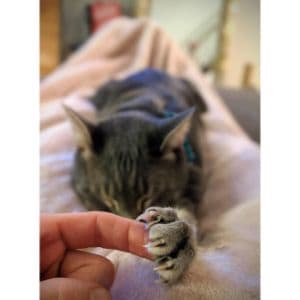
The cost of declawing a cat can vary from $200 to $800 or more.
Depending on factors such as the cat’s age, the cost of your veterinarian’s services, the cost of any necessary take-home drugs, the results of any essential pre-anesthetic examinations, and the possibility of any unforeseen complications.
Declawing is a costly procedure, and if your regular vet doesn’t do it, you may have to go somewhere else to get it done.
Declawing Cost Breakdown

Let’s move on to the next section and look at the total cost of declawing a cat. This estimate of how much it will cost to declaw a cat is just that—an estimate—because there are so many variables at play.
Cost of Pre-Testing
This is the equivalent of a thorough physical examination by a doctor. This means they must submit to further testing, including blood tests and a physical exam (which will cost around $50).
The doctor can determine if blood-thinning medications or additional factors will slow healing by taking a blood sample. In addition, a CBC is necessary for assessing the general health of some kittens.
The cost of these exams will be around $80 at most veterinary hospitals. For senior cats, the checkup cost might rise to $200 if additional tests, including a urinalysis, are performed.
Cost of Anesthesia
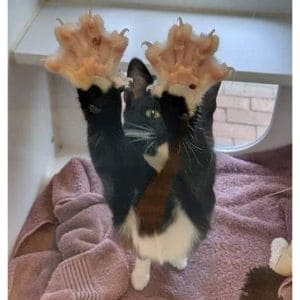
Anesthesia costs vary widely but often fall between $25 and $75. However, the price of the anesthetic will vary based on the cat’s weight and the length of the procedure.
The cost of declawing a cat increases according to the cat’s weight. The longer the procedure takes, the higher the price.
In addition, your cat’s age may play a role in the final price tag for the anesthesia. Therefore, you must schedule an appointment with your veterinarian for the most accurate cost estimate possible.
Methods for Declawing
The cost of declawing a cat might also vary depending on the type of surgery performed. Sometimes you get to pick the method you like, tailoring it to your needs and resources.
In other circumstances, however, once the preliminary testing results are in, your veterinarian will call as to which approach is best for your cat.
Additionally, you may be required to pay an extra charge of $30 or more for bandages and tissues utilized during the surgical procedure.
In order to give you an idea of what happens throughout the procedure, we’ll go over the three different types of declawing:
Onychectomy
Because the nail bed is near the first joint of your cat’s toes, this procedure involves amputating the whole toe. In other words, the surgeon will remove their bones, tendons, and ligaments. Cats’ claws are not like fingernails, but rather a part of their foot. Declawing them will hinder their ability to walk.
This is the main reason why declawing is considered a significant procedure for feline patients.
In order to minimize the amount of time your cat spends under anesthetic, many veterinarians use a device similar to a guillotine to clip its nails.
After everything has been taken out, the wound will be carefully stitched. The onychectomy treatment is simple, takes little time, and costs around $100.
Disarticulation
Disarticulation is a surgical procedure in which the physician uses a scalpel to cut your cat’s claws off at the bone. This approach guarantees they won’t be able to regrow their claws.
This procedure is more complicated than a standard onychectomy and will take longer to complete, necessitating a more extended period of anesthesia. As a result, this operation will set you back around $250.
Laser Surgery
Compared to the other two options, this one is the priciest at $250-$400. Your cat will experience less discomfort during this declawing procedure.
Your veterinarian will surgically remove the internal bone in your cat’s toes using lasers. Therefore, there is less surgical bleeding.
However, you should verify that the vet has sufficient skill to operate this technology, as accidental tissue burns could have dire effects.
Cost of Follow-Up

After the surgery, your cat will require antibiotics and pain medication. Antibiotics cost around $30, while pain relievers cost roughly $5 more.
Antibiotics are the most important thing to give your cats following surgery because of the possibility of infection. The veterinarian may recommend an oral antibiotic to reduce the likelihood of infection.
Your cat will benefit from the use of any pain medicine. This relief will last for quite a bit of time. You may also need to invest in an electronic collar for your cat to keep it from licking the wound and spreading infection.
If you want to clean your cat’s wounds, you should switch to paper cat litter once a week. You can save yourself $20 by purchasing a thirty-pound bag of paper litter.
After the declawing procedure, your veterinarian may recommend leaving your cat overnight. However, if your cat requires specialized care and treatment, the length of the visit may increase.
Possible Alternatives for Declawing Your Cat
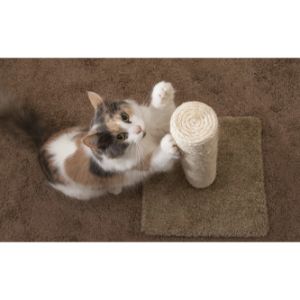
Several common alternatives to declawing a cat are available.
If you own a cat, you should:
Cut Nails
Remind yourself every two to three weeks to cut your cat’s nails. If you know what you’re doing when it comes to grooming, it’s not that hard.
Take your cat to the doctor or groomer regularly if the thought of doing it yourself makes you cringe.
Use Nail Caps
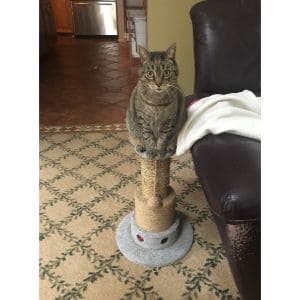
Consider covering your cat’s claws with vinyl. These will not slow your cat’s average nail growth but must be renewed every four to six weeks.
If you reward it with goodies and affection, your cat will have an easier time adjusting to any new experiences you bring.
Scratching Posts/Poles
Make scratching posts more enticing. Providing your cat with an alternative scratching surface may be all it takes to curb the bad behavior.
Provide scratching poles near his favorite spots. Find out your cat’s preference for scratching surfaces by trying out a variety of shapes, sizes, and materials.
To make them more appealing, try dusting them with some catnip.
Training

Train your cat. Preventing an issue before it ever arises is ideal. If you start early enough, you can teach your kitten to utilize a scratching post instead of your furniture, drapes, and carpet.
If you want to express dissatisfaction when your cat scratches inappropriately, try making a hissing sound or clapping loudly to indicate that you don’t approve.
Many cat owners have found success discouraging their feline friends by covering furnishings in aluminum foil.
Various remedies, from sprays to double-sided tape, can be found in pet stores and act as efficient deterrents to scratching.
Identify Triggers
Observe the house for sources of tension. When cats become bored or anxious, they may scratch at people or furniture.
They may also exhibit other undesirable behaviors, which include inappropriate spraying or excessive meowing.
Things to Consider Before Declawing Your Cat

It’s understandable if declawing a cat seems like an easy, risk-free solution to the nuisance and destruction its nail causes. However, it disregards the trauma and potential health hazards of declawing a cat.
As with any surgical procedure, there is always the chance of infection and anesthesia complications with declawing. Sometimes, some complications last for a very long time and are quite painful.
- Pain in the paws, damaged nerves, an abnormal gait, and chronic backache are all examples.
- The pain from using the litter box could discourage a declawed cat from using it again.
- Anesthesia, antibiotics, and a possible hospital stay after surgery are some additional costs that may be incurred. Prices might be as high as $1,800 or as low as $600. The added expense is a direct result of the complications.
- Some felines may experience anxiety and have trouble settling in.
- Cats that scratch for self-defense may become more aggressive after having their claws removed.
- Claws are essential for a cat’s ability to climb, grab prey, and protect itself. This is why declawed cats need to be kept indoors.
Carefully consider these factors before deciding to declaw your cat.
Frequently Asked Questions
Where is it illegal to declaw a cat?
The following cities have banned declawing a cat: Austin, TX, Denver, CO, St. Louis, MO, Pittsburgh, PA, Allentown, PA, and Madison, WI.
Will a declawed cat use a litter box?
Declawed cats tend to avoid litter boxes, because it causes them pain to cover their waste.
Will my cat hate me after being declawed?
Cats sometimes become anti-social after being declawed. They are scared of the world because their first line of defense is now gone. They are also more prone to biting.
How Much Does It Cost to Declaw a Cat?

Declawing can prove to be dangerous and extremely painful for your cat.
So, while declawing your cat may fall in your budget, we do not recommend going through with this procedure, especially in the face of healthier and pain-free alternatives.
If you find this guide, “How Much Does It Cost to Declaw a Cat,” informative and helpful, you can check out these other cat-related articles from our team:
You can learn more about declawing your cat by watching “Why Declawing Your Cat Is Actually Very Painful For Them” down below:




